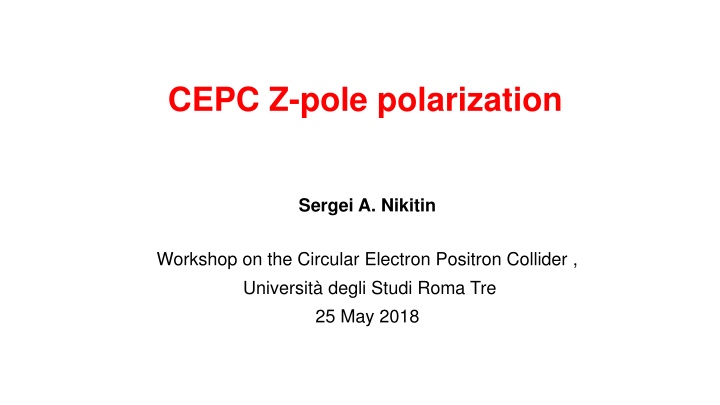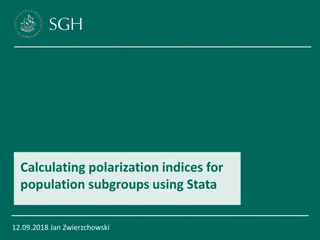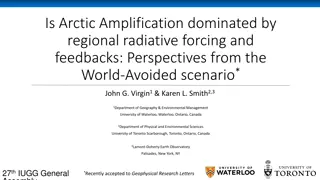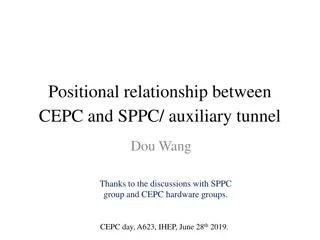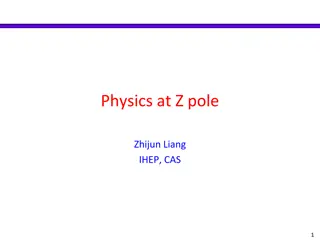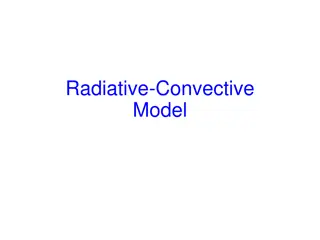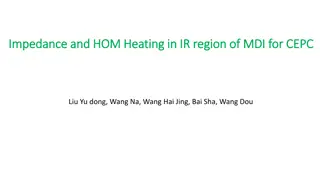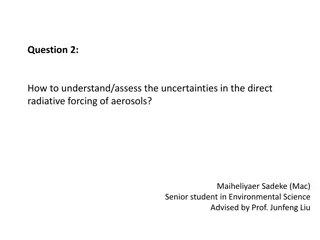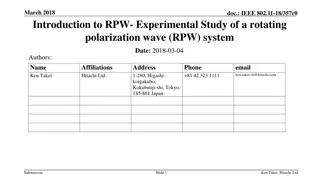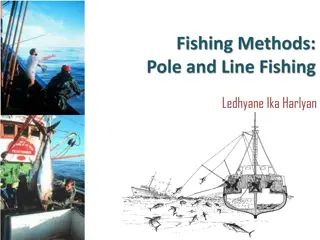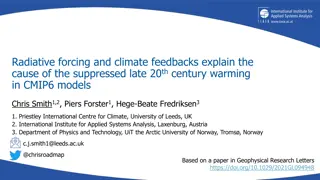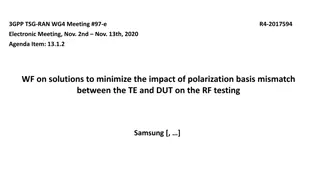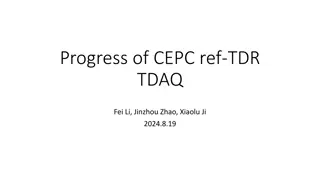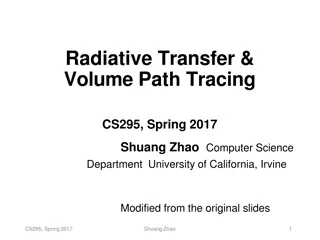Radiative Polarization Techniques in CEPC for Precision Measurements of Z-Pole Mass
Prof. Jie Gao led discussions on the CEPC polarization program, focusing on obtaining transverse and longitudinal polarizations. The use of special wigglers to enhance the polarizing effect of the magnetic field was highlighted, reducing the time needed for radiative self-polarization. Strategies to optimize the depolarization factor and decrease spin phase diffusion for efficient resonant depolarization were explored. A comparison of polarizations between CEPC and LEP was discussed, emphasizing equilibrium polarization degrees.
Download Presentation

Please find below an Image/Link to download the presentation.
The content on the website is provided AS IS for your information and personal use only. It may not be sold, licensed, or shared on other websites without obtaining consent from the author.If you encounter any issues during the download, it is possible that the publisher has removed the file from their server.
You are allowed to download the files provided on this website for personal or commercial use, subject to the condition that they are used lawfully. All files are the property of their respective owners.
The content on the website is provided AS IS for your information and personal use only. It may not be sold, licensed, or shared on other websites without obtaining consent from the author.
E N D
Presentation Transcript
CEPC Z-pole polarization Sergei A. Nikitin Workshop on the Circular Electron Positron Collider , Universit degli Studi Roma Tre 25 May 2018
Instead of introduction Prof. Jie Gao initiated discussion with us on CEPC polarization program in Nov. 2017 First qualitative view at various ways to obtain transverse and longitudinal polarizations in 45 GeV CEPC. Talk at IAS Program on High Energy Physics 2018 in Hong Kong (Jan. 2018) Next is to study where and how each of these ways ends Most hot issue. Transverse beam polarization for precision measurement of Z-pole mass basing on resonant depolarization technique. Study in progress In present talk, important quantitative details of this issue are discussed Goal is to determine and ensure conditions under which radiative self-polarization in collider rings reaches required degree within reasonable time
Radiative self-polarization in CEPC Long-known tool: special wigglers amplify polarizing effect of storage ring magnetic field! Sokolov-Ternov time of polarization in CEPC is huge: 260 hrs at 45 GeV! At 80 GeV, this time falls as (45/80)5 to 15 hrs. 45 GeV LEP: 5 hours Similar to proposal for FCCee project
Special wigglers to speed up polarization Shifter magnet Calculated for current CEPC-Z magnetic structure
Radiative polarization in real storage ring Shake of precession axis due to quantum fluctuations non-resonant spin diffusion growing nearby spin resonances, main depolarization factor in storage rings as long as spin tune spread is much less than distance to closest dangerous resonances
Depolarization factor with synchrotron modulation = is index of modulation ;
Parameter of spin phase diffusion Decrease of modulation index by increasing synchrotron tune is desirable in viewpoint of efficiency of resonant depolarization technique (see I.Koop s Talk ) In our interpretation, this is recommendation to move from range 1 to range <<1 * indicates cases with wigglers to speed up polarization
Comparison of polarizations at CEPC and LEP Equilibrium polarization degree G=P/P0for LEP and CEPC at the same spin harmonic amplitude |wk|=2 10-3 LEP: no special wigglers were used CEPC at left: good conditions for conservation of polarization in luminosity mode of magnetic structure (wigglers are turned off) CEPC at right: in wiggler mode, equilibrium degree of polarization noticeably decreases Only harmonics k=103 and k+1=104 are turned on with assumption |wk|= |wk+1|
Calculation vs observation: LEP experience Polarization (%) It is important to reduce the resonant harmonic amplitudes in orbit distortions down to level |wk| 10-3 using special orbit bumps or global correction. There was positive experience of LEP team: polarization was improved to more than 35 % with average around 50% using Harmonic Spin Matching technique (R. Assmann , A.Blondel et.al., CERN SL/94-62 (AP)
Depolarizing effect of quad tilts at LEP Equilibrium degree of radiative polarization vs beam energy in units of spin tune at LEP (Blue Book design 1978) with 5 10-4rad spread of quadrupole tilt angles. Dips correspond to integer =k and intrinsic spin resonances x=k and y=4 k . Their partial width achieves 50 MeV. Below, cross section of Z-boson ( tot=2.5 GeV) is plotted on the same energy scale. Working point ( x, z) of LEP occupies intermediate position between integer and half-integer values. It is compatible with necessity to have energy of experiment close to half integer values of spin tune because of strong depolarizing effect of vertical orbit distortions. A similar situation seems to be the case with FCCee and CEPC. No synchrotron modulation taken into account. Appropriate sideband resonances could be noticeably narrower than in case of vertical orbit distortions
Effect of energy spread increase on polarization Equilibrium polarization degree in region of Z-pole vs spin tune in two cases of wiggler mode |wk|=10-3 B+=0.5 T energy spread =9.9e-4 spin tune spread =0.103 B+=0.6 T energy spread =1.25e-3 spin tune spread =0.128
CEPC polarization at 80 GeV No special wigglers needed! |wk|=5 10-4 In comparison with Z-pole case, this one is harder. Spin harmonic amplitude in vertical closed orbit perturbations should be corrected to level < 5 10-4.
Time to reach h% polarization in CEPC While using laser polarimeter for RD technique it is enough to ensure polarization degree about of 10% *) B+=0.5 T **) B+=0.6 T
Polarization scenario at 45 GeV (qualitatively similar to FCCee concept) About 100 pilot bunches of relatively small total current Ip are stored to be polarized up to 10% using wigglres in a few of hrs 3 kW SR power from each of 0.6 T wigglers at total current of pilot bunch train of Ip =2 mA (~1% of the main train) When the polarization process ends the wigglers turn off Then the main bunch train is stored Pilot bunches are not in collision. Their lifetime is about 105s due to scattering on thermal radiation photons (like at LEP). The bunches are used one by another for RD calibration of beam energy every 15 min. So, the polarized bunch train is spent as a whole per day while taking data in detector occurs
Response of transverse field perturbations in spin motion CEPC: m=2 Properties of this function were studied and confirmed in experiments at VEPP-4 and VEPP-4M
Spin response function at two CEPC energies Analytic formula-based calculation E=45. 387 GeV (Z) =103 E=80. 198 GeV (W) =182 CEPC structure on 07.11.2017 x=355.103 y=355.215 CEPC structure like at Z x=355.103 y=355.215 At energy of W pair production threshold, |F | is noticeably larger. It makes requirements to field imperfections harder. Z-pole region: Spin Response Function module is quite moderate.
Tracking-based method to calculate F Compare these two graphs! Attention! z stands for y! S.A. Nikitin. Talk at 20th Intern. Spin Physics Symposium (SPIN 2012), 17- 22 Sept. 2012, Dubna, Russia Cross-checking OK!
Spin response in resonant depolarization technique Efficiency of RF transverse field depolarizer depends on Spin Response Function module at azimuth of depolarizer placement as well as on rate of frequency scanning Basing on knowledge of |F | magnitude, depolarizer is tuned to can depolarize at main spin resonance but to be not enough in strength for that at sideband (more weaker) ones
Estimate of spin harmonic amplitude at 45 GeV 45387 MeV < EZ =45594 MeV < 45828 MeV k=103 k=104
Summary Depolarization effect of quantum fluctuations in presence of vertical closed orbit distortions at CEPC has been estimated taking into account modulation of spin frequency by synchrotron oscillations. Resonance harmonic amplitude is input parameter Spin harmonic amplitude of vertical closed orbit distortion sources at Z-pole should be corrected to level 10-3to ensure 50% equilibrium polarization degree If this is done, it is possible to reach polarization in range (6-10)% in 45 GeV CEPC in time of (2-4) hours using, for instance, ten shifter magnets with moderate characteristics Sensitivity of spin motion disturbances to transverse field imperfections is determined through Spin Response Function which has been calculated in two ways At 45 GeV, expected harmonic amplitude of closest integer spin resonance calculated at typical magnitudes of misalignment (50 m, 3 10-4rad) is about 3 times larger than desirable one. Correction of resonance harmonics (k= 103 and k= 104) is needed. Similar problem was successfully solved at LEP
What is next Using Spin Response Function , estimate depolarization effect of quantum fluctuations in presence of other, more weaker than vertical orbit distortions, sources of spin-orbit coupling. For instance, disturbances with spin-betatron resonances x=k and y=2k Influence of combination of transverse and longitudinal magnetic fields in interaction region on polarization (no spin transparency + radiation in detector solenoid field owing to non-zero crossing angle) Numerical simulation of spin harmonic correction Refine conditions for radiative polarization at W energy Estimate depolarization effect of resonance diffusion of polarization due to stochastic crossing spin resonances at large spin tune spread in framework of model basing on radiative excitation and damping Compare with results of polarization simulation on FCCee
I am grateful to Prof. Jie Gao for initiation of this discussion. I thank Anatoly Kondratenko for conversations on spin dynamics; Evgeni Levichev, Ivan Koop, Dmitry Shatilov and Sergei Sinyatkin for useful discussions on FCCee project; Dou Wang, Dengjie Xiao and Yiwei Wang for technical help THANK YOU FOR ATTENTION!
